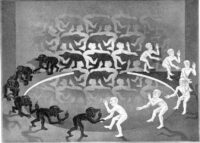The doorbell rings and outside the door is a well-dressed young white man. How do you feel? Or, outside the door is a well-dressed young black man. Do you feel differently? Or, in either case, the young men are poorly dressed. How does that affect your feelings? Or, it’s a policeman dressed in uniform at your door; what then?
The emotional experiences of fear and safety begin in infancy. How we resolve such feelings as infants resides at the center of ideas about human psychological development, such as attachment theory, about how and why we grow up to become the sorts of people we are.
Although none of us can remember events from during the first year of life, it is in this period that emotions first arise and we are challenged in coming to terms with them. This early process may greatly influence the complexion of the rest of our lives. While disposition is both natural and developed, which is to say that while each of us is born bearing essential elements of personality, we are also subject to the influence of environment and parenting – the combination of nature and nurture. We all face the challenge of coming to terms with the experience of being human: working with what we are given and making choices.
We exit infancy biased in small ways and large; at its core bias is a result of the experience of like and dislike. The choices we make later in life reflect our biases, and as we age we face the degree to which we are capable and prepared to examine, accept and reject bias. Social convention, group-think and peer pressure all serve to repress inclinations to examine our biases; having accepted an article of “truth” we are loathe to question it for fear of being ostracized, excluded, or punished. Yet, for all the power of bias – the prohibitions and taboos to which we are subject – an inclination towards transgression arises just as powerfully, and we often discover that what we have accepted as absolute truth is anything but.
Bias is not destiny; through the process of examination it can be altered, if not totally eliminated. Elimination is not necessarily realistic or preferable; one can legitimately argue that bias can benefit survival, as in preferring pet dogs to pet tigers, for example. When cultural bias is accepted as absolute truth, however, and rises to the level of dogma, it manifests as bigotry. In this way, racial, ethnic and religious bias have fueled conflict, trauma and death, and continues to do so.
Overcoming bias is a matter of honestly recognizing it and choosing how to respond to it rather than succumbing to its fixed emotional operation. We cannot escape our inclinations to bias, but we can influence how we are affected by it and our response. In doing so we need not abandon intuition or common sense, but we must be willing and able to determine to degree to which any bias has become dogma and impervious to either compassion, logic or events.
The context and experience of our individual lives play upon our feelings and biases; we cannot escape that reality and being sensible, aware, and cautious are generally appropriate in an unpredictable world. The reasons we trust or do not trust others may stretch all the way back to infancy, but unless we recognize, examine and alter our bias, we’re doomed to bigotry.






Be First to Comment